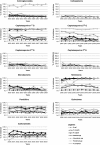Frequency and antimicrobial resistance patterns of bacteria implicated in community urinary tract infections: a ten-year surveillance study (2000-2009)
- PMID: 23327474
- PMCID: PMC3556060
- DOI: 10.1186/1471-2334-13-19
Frequency and antimicrobial resistance patterns of bacteria implicated in community urinary tract infections: a ten-year surveillance study (2000-2009)
Abstract
Background: Urinary tract infection (UTI) is one of the most common infectious diseases at the community level. In order to assess the adequacy of the empirical therapy, the prevalence and the resistance pattern of the main bacteria responsible for UTI in the community (in Aveiro, Portugal) was evaluated throughout a ten-year period.
Methods: In this retrospective study, all urine samples from patients of the District of Aveiro, in ambulatory regime, collected at the Clinical Analysis Laboratory Avelab during the period 2000-2009 were analysed. Samples with more than 105 CFU/mL bacteria were considered positive and, for these samples, the bacteria were identified and the profile of antibiotic susceptibility was characterized.
Results: From the 155597 samples analysed, 18797 (12.1%) were positive for bacterial infection. UTI was more frequent in women (78.5%) and its incidence varied with age, affecting more the elderly patients (38.6%). Although E. coli was, as usual, the most common pathogen implicated in UTI, it were observed differences related to the other bacteria more implicated in UTI relatively to previous studies. The bacteria implicated in the UTI varied with the sex of the patient, being P. aeruginosa a more important cause of infection in men than in women. The incidence of the main bacteria changed over the study period (P. aeruginosa, Klebsiella spp and Providencia spp increased and Enterobacter spp decreased). Although E. coli was responsible for more than an half of UTI, its resistance to antibiotics was low when compared with other pathogens implicated in UTI, showing also the lowest percentage of multidrug resistant (MDR) isolates (17%). Bacteria isolated from females were less resistant than those isolated from males and this difference increased with the patient age.
Conclusions: The differences in sex and age must be taken into account at the moment of empirical prescription of antimicrobials. From the recommended antimicrobials by the European Association of Urology guidelines, the first line drugs (pivmecillinam and nitrofurantoin) and the alternative antibiotic amoxicillin-clavulanic acid (AMX-CLA) are appropriate to treat community-acquired UTI, but the fluoroquinolones should not be suitable to treat male infections and the trimethoprim-sulfamethoxazole (SXT) shall not be used in the treatment of UTI at this level.
Figures



References
-
- Arjunan M, Al-Salamah AA, Amuthan M. Prevalence and antibiotics susceptibility of uropathogens in patients from a rural environment. Tamilnadu. Am J Infect Dis. 2010;6:29–33. doi: 10.3844/ajidsp.2010.29.33. - DOI
-
- Rahman F, Chowdhury S, Rahman MM, Ahmed D, Hossain A. Antimicrobial resistance pattern of gram-negative bacteria causing urinary tract infection. S J Phar Sci. 2009;2:44–55.
-
- Narciso A, Fonseca F, Cerqueira SA, Duarte A. Susceptibilidade aos antibióticos de bactérias responsáveis por cistites não complicadas: estudo comparativo dos isolados de 2008 e 2010. Acta Urol. 2011;1:16–21.
-
- Sheerin NS. Urinary tract infection. Medicine. 2011;39:384–389. doi: 10.1016/j.mpmed.2011.04.003. - DOI
Publication types
MeSH terms
Substances
LinkOut - more resources
Full Text Sources
Other Literature Sources
Medical
Miscellaneous

